The objective of this report is to see how the Korean festival 2008 contributes to the tourism industry as well how successful the festival is due to its marketing techniques. This will be done through a field trip to the Korean Flavour Fiesta which was conducted on the 2nd of November, 2008.
The Korean Festival 2008 is a festival organized by the Embassy of the Republic of Korea to showcase Korean culture in many aspects ranging from Korean food, Korean music to Korean traditional costumes in a bid to improve relations between Singapore and Korea as well as share the different aspects of Korean culture with the people residing in Singapore. The duration of the festival lasts from the 1st to the 18th of November and is available at different venues all around Singapore at different dates.
I decided to attend the Korean Flavour Fiesta held at the Sky Park of VivoCity (3rd Level) on the 2nd of November as I was curious about how the festival was like after having heard about it via word of mouth and having watched a television program on Channel News Asia introducing the event.
The Korean Flavour Fiesta had programs planned out from as early as 1pm to 8pm and had many performances and activities lined up ranging from Taekwondo demonstrations to Kim chi making classes.
As we know, the success of an event is dependent on how an event is marketed through the use of the marketing mix which consists of product, place, partnerships, promotion, programming, people, packaging and distribution and price to attain the organizational goals through creating value for customers and other stakeholders. It is thus, important to know how to get them right and how each one works to create success for the event as the whole, which I will now touch on, starting with the Place factor of the marketing mix.
Place
The place factor is concerned with the location, setting, atmosphere and other features of the destination.
The Korean Flavour Fiesta was located at the Sky park of VivoCity, close to the Sentosa expressway ticket office, which I personally felt was a good idea because it was not only readily accessible through escalators and lifts but also a good location in the sense that it gave the fiesta more exposure to people who might not have known about the fiesta firsthand and had merely been there to either visit Sentosa or do their shopping, thus generating more people patronage at the Korean Flavour Fiesta.
The layout and positioning of the different booths was also done reasonably well with the stage being placed in the centre and thus, encouraging the patronization of other related booths situated on the way to the auditorium of the stage and eliminating any chances of the guests missing out of any of the stalls. The open air concept also made the area seem larger and more welcoming.
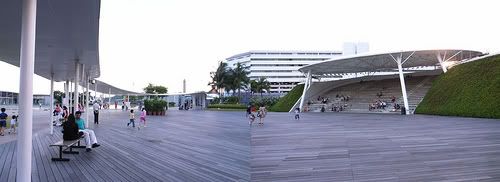
(A picture of the Vivo Skypark before the setting up of the event. Note how the space seems airy and broad.)
My only complaint is that the path to the areas connecting the stage to the trying out of the Korean traditional costumes booth was too narrow and got a little difficult to navigate sometimes. This is especially so before or after the end of a performance as many of the performers would be crowded along that area and thus slowing down human traffic. Also, more decorations could be used to decorate the various stalls and booths around the area to make it seem livelier instead of just having all the tents in the usual shades of white.
Product
The product which the Korean festival offers would be the experience of allowing the visitor to be in contact with the different aspects of Korean culture, whether it is their music and food or their traditional costumes and dances.
As experience is an intangible product, it is hence, crucial for the organizers of the Korean festival to ensure the quality of it.
Personally, I thought the organizers did a good job on their product concept and they did not suffer from too much of “product orientation”. It was clear who their target markets were as they repeatedly emphasized on the “happening” part of the Korean festival, with the constant reference to the Korean Pop night concert, Korean film festival and the Korean Flavour Fiesta, thus attracting many of those who are interested in the Korean culture.
Furthermore, with the addition of local Korean people being the performers or some of the booth assistants in booths like the free kim chi making classes and indulging in Korean food booth, the authenticity of the festival is boosted, making it an appropriate choice of destination to visit for those die hard fans of the Korean culture.
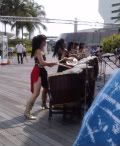
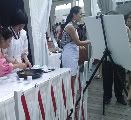
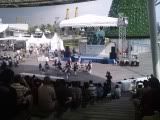
(From Left to right: The Korean Fusion drum ladies, some of the booth helpers and the dance performers of Sa-Mool-No-Ri.)
Price
Pricing is one of the important components of the marketing mix as it can determine how successful and event is, especially so if the event is based or created for a commercial basis. Although the Korean festival was a non-ticketed event which meant that anyone could visit, it does not necessarily mean that everyone would have been interested or encouraged to go to it as there are often other prices in the sense of opportunity costs and travel costs.
In my opinion, I do find the traveling time and the distance to Vivocity where the Korean Flavour Fiesta was held a bit too long and time consuming. Furthermore, because of the fact that it was free admission and that meant I had no obligation to attend it, it kind of dampened my motivation to do so, had it not being for the sake of this project. Perhaps the organizers could take the distance factor into consideration and try to re-locate to a better location like for example, in the city centre if they do intend to carry out the Korean Flavour Fiesta next year. It might be a bit costlier because of so but the organizers could always introduce ticketing charges for the event or seek out more sponsors to aid in funding.
I also found the pricing range of some of the merchandise offered on sale a little higher than average, especially so for the DVDs and movies sold at the Korean Entertainment booth. Although this is understandable as the vendors are looking to earn a profit to cover the expenses incurred from the rental of the stall but the range of Korean movies and dramas provided was also limited and I was rather disappointed. The organizers could have probably improved on this by collaborating with local video selling chains like Blue Max or TS instead which offer a wide variety of Korean related DVDs and movies at reasonable prices which might have encouraged more people to buy them instead of just briefly looking at the stall and then walking off.
People
As the nature of an event or festival is that it is intangible and inseparable, meaning that only when one participates in it is he or she able to tell if the event lived up to his or her expectations or not, it is thus crucial that the experience for the visitor as made as perfect and enjoyable as possible. Hence, we can see that the people factor holds an integral part in the marketing mix.
In this case, the “cast” of the Korean festival would be the various vendors in charge of different booths, the emcee as well as the performers. All of whom are essential in making the Korean festival a success as they are technically part of the experience which is the product sold to the customers.
The emcee and the performers were generally enthusiastic and friendly, often interacting with the audience. Like for example, during the dancing unit; B-Boys performance, the performers encouraged the audience to clap along and called out greetings, hence enhancing the atmosphere of excitement.
However, some of the respective booth helpers’ attitudes could have used some improvement. In the two booths which I visited, namely, the food products booth as well as the entertainment section, the helpers there seemed rather moody and distant, choosing to stand at the side or at their post instead of coming forward to serve. To make things worse, at the time when I patronized both booths, there were very little customers around, with the inclusion of myself, yet the staff tending the booth seemed reluctant to attend to any of us.
This is quite a pressing problem because if the staff is unwilling to make any form of interaction with the customers visiting their booths, it will leave a bad impression of the companies renting the booths as well as the organizers of the Korean Flavour Fiesta on the customers. I thus suggest that the organizers look into methods of boosting the morale of the various staff, like for example, organizing pre-service talks about why it is important to uphold good service. Alternatively, the organizers could also pre-arrange with the various companies renting the booths to make sure that incentives of some form are provided to the helpers at each respective booth if they do well on their jobs and provide good service.
Promotion
Promotions for a festival or event usually makes use of the full communication mix which includes advertising, public relations and sales promotions and needs to be maintained and consistent over a period of time right up to the commencement of the event or festival.
For the Korean festival, its main form of advertising were mainly through posters, banners and television, namely Channel News Asia which was the main TV station that aired reports and helped in the promotion of the Korean Flavour Fiesta as well as the Korean festival on the whole.
I happened to be able to watch one of the special TV programmes featuring the Korean Flavour Fiesta on Channel news Asia and in the programme itself, when they were introducing the various activities which they would have at the Korean Flavour Fiesta, images from Korean dramas that were aired previously on television such as the characters from the popular Korean food drama, Jewel in the Palace along with some Korean music were added in as effects. I think this is a smart marketing move on their part because by doing so, it will not only attract those who are interested in the Korean culture but also help audiences to form an image as to what to expect at the Korean festival, which is basically to be able to get a taste of the Korean culture that they have been seeing in TV serials and dramas so far.
The Korean Pop night concert which features many popular and upcoming Korean stars like Jun Jin, Wonder Girls and Jewelry to boot, also helps generate hype for the Korean festival as well as publicity as the media becomes interested in what these invited Korean stars have to offer for their Singaporean fans. This will help strengthen the image that the Korean festival is a big and “happening” event which should not be missed by fans of the Korean culture and thus induce them to find out more the event and the other ways they can participate in, besides attending the Korean Pop night concert. This is further emphasized by the fact that many of the online Korean interest forums as well as personal blogs have also posted details of the event, thus spreading the word of mouth about it and generating more publicity for the Korean Festival on the whole.
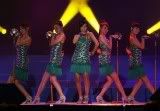
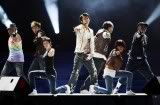
(From left: The wonder girls. JunJin; Korean Pop night. )
Besides, the ticketing information and details of Korean Pop night are all located on the official website of the Korean festival and by doing so, it will allow those who visit the website with the interest of getting a ticket to come into contact with the other programmes and activities that the Korean Festival has to offer like, the Korean Film Festival at Lido Cineplex, Shaw house for example, thus further promoting the festival on the whole to as big a target audience as they can.
Strangely, there weren’t much write ups in local newspapers about the Korean festival and the events they had to offer and even if they were some which did, they mostly focused on the aspect of the Korean pop night concert and not so much on the other aspects which was a bit disappointing. Perhaps the organizers could think about holding a pre-event conference to inform the media of the possible news worthy events that they could feature and write about so as to improve the situation of the lack of public relations factor. This is important as the media is an influential factor in ushering in people traffic for such events or festivals and just promoting the festival through a channel on television itself is not sufficient to draw the maximum number of people that might be interested to come to the Korean Festival. Besides, majority of the people tend to place more trust in whether a product is good or reliable via the recommendations or write up of the media resources that the event organizers cannot control, which is namely, the feature articles on the newspapers.
Partnerships
It is common in the marketing of events and festivals to come across the formation of partnerships that engage in joint marketing and most of these partners include tourism organizations, governmental agencies and so on. That is because, usually single events often cannot, on their own achieve their marketing goals.
In the case of the Korean Festival, the most obvious partner would be the Korean Tourism Organization as well as Singapore’s own Tourism board, STB. That is because the purpose and theme of the Korean festival is, “Communication and Sharing”, which is to promote and share Korean culture via the Korean people themselves to the Singaporeans. Thus, it is crucial that the event organizer, which is the Embassy of the Republic of Korea work hand in hand with the Korean Tourism Organisation so as to decide which part of Korean culture they want to be shared and promoted and the various ways in which it would be done so, for example, like the organizing of kpop music concerts and performances and so on, hence the reason to form a partnership and do joint marketing together.
Also, from the official website created for the event and the brochure given, we can also see that the Korean Tourism Organisation is also a sponsor of the Korean festival and this shows that it is a stakeholder in producing the Korean festival and thus it would want to ensure that it’s objectives of promoting and encouraging more people to visit Korea is met besides the organiser’s aim of spreading and sharing the Korean culture and customs among Singaporeans. In fact, the Korean Tourism Organisation ‘s message of encouraging people to visit Korea through the Korean festival is also further evident in the setting up of booths for Korean Air and Asiana Airlines respectively, where attractive travel packages and promotions were offered to encourage people to purchase and visit Korea.
As for the role of the Singapore Tourism Board, it is mainly to promote the Korean Festival 2008 as one of the major events to look out for in the Singapore calendar of events as so stated in it’s official website so as to encourage more people to visit they event regardless of whether they are local or not.
Programming
Programming is another crucial factor besides the product which will help in the success of an event. The Korean festival consisted of many events interlinked together, each with their own set of programmes. One of them would be the Korean Flavour Fiesta which provided a variety of programmes ranging from taekwondo demonstrations to the trying out of Korean traditional costumes.
I found the list of activities and programs provided at the Korean Flavour Fiesta relatively varied and interesting. They not only managed to showcase the things that Korean is famous for like the Kim Chi making and taekwondo but they also managed to incorporate other activities that are unique and related to Korea like the photograph taking session for the trying out of Korean costumes as well as a booth on Samsung to emphasize on Korea’s latest breakthrough in technology wise.


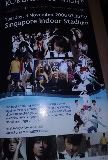
However, I felt that the consistency of the program timings could have be improved. That is because on the day which I attended the Fiesta which was on a Sunday, the 2nd of November, many of the performances did not seem to manage to able to keep onto schedule as stated in the timings provided in the brochures given out. For example, instead of the Taekwondo demonstration commencing at 3.30pm, it started as early as 3.15pm instead, causing the entire programme schedules to be pushed forward and this caused guests who wanted to watch a specific program and arriving at the stated timing to either miss half or all of the performance, thus causing frustration and irritation, which was what exactly happened to my friend who actually wanted to watch the Sa-Mool-No-Ri performance at 4pm, but by the time she arrived, the performance was already halfway through.
The strange thing is that according to my other friends who went for the Korean Flavour Fiesta the day before on Saturday, everything was on schedule and followed the exact timings as stated in the brochure given. Hence, this shows that there is a lack of consistency in maintaining and ensuring that the performances stick to the schedule. I think that this is a problem that the organizers should look into if they do intend to set up another similar festival in the future in Singapore so as to minimize the possible disappointment and frustration felt by the visitors if they do miss any of the showings.
Packaging and Distribution
A package is any combination of elements offered for sale at a single price. Packaging seeks to make the event experience more attractive by lowering costs, maximizing convenience, or providing “value added” in the form of extra features that cannot be obtained otherwise.
As the Korean Flavour fiesta is a non-ticketed and free event, there was not much packaging of any services or attractions along with the Korean Festival. There was however, some travel packages offered by the Asiana and Korean airlines that had set up booths at the Korean Flavour Fiesta. Also, there was a lucky draw organized with several attractive prizes and packages like, for example, the top prize on the 2nd of November was two business class tickets to Korea on Asiana Airlines. I think this is a smart move on the part of the organization as it not only helps draw attention to Asiana Airlines which is one of their sponsors but also provides some form of entertainment value to the overall experience at the Korean Flavour Fiesta.
Tourism role of event
As mentioned earlier, the Korean festival was organized by the embassy of the republic of Korea in an attempt to share the values and traditions of the Korean culture and create awareness of it in Singapore while at the same time, promoting Korea as a travel destination. In this way, what the organizers stand to benefit from the event is that their country, Korea is able to be exposed to a larger target audience and thus increase the probability of more people in Singapore choosing Korea as their new travel destination the next time they decide to book a trip overseas. The Korean festival also helps to promote multi-racial ties and harmony among the different nationalities involved namely the Koreans and the people residing in Singapore.
On the other hand, Singapore also gains some of the benefits as the Korean Festival generates tourism receipts and helps in the increase in visitor arrivals. This is because some of the performers from Korea have to fly into Singapore just to perform for the event, hence boosting Singapore’s tourism industry in the process. This not only helps the economy in the sense of the increasing tourist receipts but also gives Singapore an opportunity to showcase and promote itself as a destination with many interesting festivals and events to the people overseas. This is evident in the fact that the Korean Festival 2008 was even marked down as an event to look out for in the Singapore Tourism Board’s website, thus creating publicity for it and showing the significance of the event and its tourism role and value.
Conclusion
Overall, the Korean festival, or more specifically the Korean Flavour Fiesta which I attended gave me a new perspective on the Korean values and tradition in general. Through the event I learned a lot of new things that I previously did not know about Korea, like how their costumes are worn and the different variety of food they eat during the four seasons.
Although there were several factors of the marketing mix that could have used some improvement like the people, programming and price factor, I found the event relatively successful largely due to the product that they offered as well as the promotion done for the Korean Festival.
The organizers were clear about who they intended to attract to the event with their product and used appropriate ways of promotion to attract them whether it is through the television with the use of the often associated Korean imagery or through banners and the booking of tickets and detailed information on their specially event created website which helped them reach their target audience as quickly as possible.
A lot of effort was also placed into generating hype for the Korean Festival itself while at the same time promoting the Korean culture, either through the Kpop singing competition held or the Korean film festival which featured many epic Korean movies.
There are still some ways in which the organizers can improve about going about the Korean Festival though. One of which is to consult the actual Korean fans as to what acts or performances and activities they would like to see and take part in if they do decide to hold another Korean festival in Singapore next year. Like for example, some of the fans were disappointed that acts like Big Bang, DBSK or F.T Island were not chosen to perform in the Korean Pop Night or the fact that the tickets to the Korean Pop night concert could not be purchased.
Consistency is also another point that they might want to take into consideration, regardless of whether it is consistency in the service provided or in things such like the programme timings as these factors are important in shaping the customer experience which will ultimately decide whether the event is successful or not.
All in all, it was an interesting experience and I look forward to being to able to attend more of such festivals and events in Singapore in the near future.
Done by: Joan Heng Xue Li
Admission number: 0705890B
Tutorial class: T14
Word count: 3,774 words
References:
1.Allen, J. et al (2008). Festival and Special Event Management (4th ed.). Milton, Queensland: John Wiley & Sons Australia Ltd.
2.Lynn Van Der Wagen (2007). Event Management: For Tourism, Cultural, Business and Sporting Events (3rd ed.). Australia: Pearson.